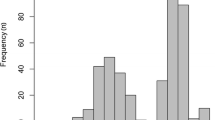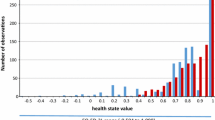Abstract
Background: Many clinical trials that generate evidence on the quality-oflife (QOL) improvements provided by new health technologies do not incorporate a preference-based generic measure, but generate only diseasespecific data. However, in order to meet the information needs of regulators such as the UK National Institute for Health and Clinical Excellence (NICE), such disease-specific data need to be converted into a broader generic measure; for NICE, the preferred instrument is the EQ-5D. The process of converting QOL data from one instrument to another is known as ‘mapping’.
Objective: The objective of this study was to examine the extent to which disease-specific measures generated in the clinical trials for a new treatment for chronic constipation (prucalopride) can be ‘mapped’ onto a preferencebased generic measure (EQ-5D and SF-6D) to generate robust and reliable utility estimates.
Methods: Disease-specific QOL data generated in the clinical trials of prucalopride (PAC-QOL scores) were converted into utility values estimated using the preference-based generic measure EQ-5D. SF-36 data were also collected in the clinical trials and used to generate SF-6D estimates for comparative purposes. Regression analysis was used to derive a range of mapping functions to identify the extent to which increasing the complexity of the hypothesized underlying mapping function enhanced the robustness and reliability of the obtained mapping relationship.
Results: The mean utility observed at baseline for chronic constipation, based on SF-36 data, was 0.813 with the EQ-5D and 0.723 with the SF-6D. An examination of the differences between predicted and observed values generally found that the mapping functions generated were robust and reliable, with little evidence of bias across the range of the dependent variable. However, the nature of the symptoms explored in the PAC-QOL measure was, in general, less severe than those explored in the EQ-5D. For example, the condition-specific measures explored the degree to which patients experienced ‘discomfort’, rather than ‘pain’ as evaluated in the EQ-5D. Given this limitation in the severity range covered in the disease-specific measures, it is perhaps not surprising that a floor effect was identified, with certain health dimensions mapping only to the upper range of the EQ-5D measure.
Conclusions: In circumstances where direct utility measurement is not available, mapping provides a valuable method by which to estimate utility data for incorporation into cost-effectiveness analyses. Our findings emphasize the importance of the structure and nature of the mapping analysis undertaken as being a fundamental determinant of the utility estimates generated. Unfortunately, the theoretical guidance available to steer such analyses is still comparatively underdeveloped and this remains an area of health economic analysis in which empiricism largely rules. Ensuring that such mapping is undertaken and interpreted in as transparent and robust a manner as possible is therefore crucial in allowing regulators to accurately compare the clinical and cost effectiveness of new drugs across therapeutic areas.







Similar content being viewed by others
References
National Institute for Health and Clinical Excellence. Single technology appraisal: specification for manufacturer/sponsor submission of evidence. London: NICE, 2009 Oct
National Institute for Health and Clinical Excellence. Guide to themethods of technology appraisal. London: NICE, 2008 Jun
Brazier JE, Yang Y, Tsuchiya A, et al. A review of studies mapping (or cross walking) non-preference based measures of health to generic preference-based measures. Eur J Health Econ 2010; 11 (2): 215–25
Buxton MJ, Lacey LA, Feagan BG, et al. Mapping from disease-specific measures to utility: an analysis of the relationships between the Inflammatory Bowel Disease Questionnaire and Crohn’s Disease Activity Index in Crohns disease and measures of utility. Value Health 2007; 10 (3): 214–20
Brazier J, Czoski-Murray C, Roberts J, et al. The King’s Health Questionnaire: estimation of a preference-based index from a condition-specific measure. Med Decis Making 2008; 28 (1): 113–26
Camilleri M, Kerstens R, Rykx A, et al. A placebocontrolled trial of prucalopride for severe chronic constipation. N Eng J Med 2008; 358 (22): 2344–54
Tack J, Van Outryve M, Beyens G, et al. Prucalopride (Resolor®) in the treatment of severe chronic constipation in patients dissatisfied with laxatives. Gut 2009; 58: 357–65
Quigley EMM, Vandeplassche L, Kerstens R, et al. Clinical trial: the efficacy, impact on quality of life, and safety and tolerability of prucalopride in severe chronic constipation: a 12-week, randomized, double-blind, placebo-controlled study. Aliment Pharmacol Ther 2009; 29: 315–8
Marquis P, de la Loge C, Dubois D, et al. Development and validation of the Patient Assessment of Constipation Quality of Life questionnaire. Scand J Gastroenterol 2005; 40 (5): 540–51
Dubois D, Gilet H, Viala-Danten M, et al. Psychometric performance and clinical meaningfulness of the Patient Assessment of Constipation — Quality of Life questionnaire in Prucalopride (RESOLOR®) trials for chronic constipation. Neurogastroenterol Motility 2010; 22: c54–63
Frank L, Flynn J, Rothman M. Use of a self-report constipation questionnaire with older adults in long-term care. Gerontologist 2001; 4 (6): 778–86
Frank L, Kleinman L, Farup C, et al. Psychometric validation of a constipation symptom assessment questionnaire. Scandinavian J Gastroenterol 1999; 34: 870–7
Rowen D, Brazier J, Roberts J. Mapping SF-36 onto the EQ-5D index: how reliable is the relationship? Health Qual Life Outcomes 2009 Mar 31; 7: 27
Ara R, Brazier J. Deriving an algorithmto convert the 8 mean SF-36 dimension scores into a mean EQ-5D preferencebased score from published studies (where patient level data are not available). Value Health 2009; 12 (2): 346–53
Rowen D, Brazier J, Roberts J. Mapping SF-36 onto the EQ-5D index: how reliable is the relationship? Health Qual Life Outcomes 2009 Mar 31; 7: 27
Franks P, Lubetkin EI, Gold MR, et al. Mapping the SF-12 to the EuroQol EQ-5D Index in a national US Sample. Med Decis Making 2004; 24 (3): 247–54
Gray AM, Rivero-Arias O, Clarke PM. Estimating the association between SF-12 responses and EQ-5Dutility values by response mapping. Med Decis Making 2006; 26 (1): 18–29
Gray AM, Rivero-Arias O, Willison KD. Estimating the association between SF-12 responses and EQ-5D utility values by response mapping. Med Decis Making 2006; 26 (1): 18–29
Patient Reported Outcomes (PRO) Newsletter 2008; 40 [online]. Available from URL: http://www.pro-newsletter.com/images/PDF/pron40-final.pdf [Accessed 2011 Feb 9]
Brazier J, Roberts J, Deverill M. The estimation of a preference-based measure of health from the SF-36. J Health Econ 2002 Mar; 21 (2): 271–92
Kopec JA, Willison KD. A comparative review of four preference-weighted measures of health-related quality of life. J Clin Epidemiol 2003 Apr; 56 (4): 317–25
Brazier JE, Roberts JR. The estimation of a preferencebased index from the SF-12. Med Care 2004; 42: 851–9
Acknowledgements
The case study described in this article was partly funded by an unrestricted educational grant from Movetis. The authors’ analysis was undertaken entirely independently of the funders.
The authors gratefully acknowledge the expert advice and guidance provided by Professor John Brazier and Dr Antonieta Medina Lara in the preparation of this paper.
Author information
Authors and Affiliations
Corresponding author
Rights and permissions
About this article
Cite this article
Parker, M., Haycox, A. & Graves, J. Estimating the Relationship between Preference-Based Generic Utility Instruments and Disease-Specific Quality-of-Life Measures in Severe Chronic Constipation. Pharmacoeconomics 29, 719–730 (2011). https://doi.org/10.2165/11588360-000000000-00000
Published:
Issue Date:
DOI: https://doi.org/10.2165/11588360-000000000-00000




